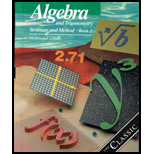
Concept explainers
(a)
To find: The probability of the given event.
(a)
Answer to Problem 12WE
The probability for the given event is
Explanation of Solution
Given:
The event is “Both are hearts.”
Calculation:
To solve, the required probability it is must to determine the probability of each draw.
Since when 2 cards are drawn, then there is one less card to draw in the deck so now there are 51 cards remaining.
Multiply the probabilities together to get the required probability.
There are 13 hearts in the first draw and 12 hearts in the second.
The probability of the given event is as follows.
Therefore, the probability for the given event is
(b)
To find: The probability of the given event.
(b)
Answer to Problem 12WE
The probability for the given event is
Explanation of Solution
Given:
The event is “both are jacks.”
Calculation:
To solve, the required probability it is must to determine the probability of each draw.
Since when 2 cards are drawn, then there is one less card to draw in the deck so now there are 51 cards remaining.
Multiply the probabilities together to get the required probability.
There are 4 jacks in the first draw and 3 in the second.
The probability of the given event is as follows.
Therefore, the probability for the given event is
(c)
To find: The probability of the given event.
(c)
Answer to Problem 12WE
The probability for the given event is
Explanation of Solution
Given:
The event is “neither is red.”
Calculation:
To solve, the required probability it is must to determine the probability of each draw.
Since when 2 cards are drawn, then there is one less card to draw in the deck so now there are 51 cards remaining.
Multiply the probabilities together to get the required probability.
There are 26 black cards on the first draw and 25 black cards on the second.
The probability of the given event is as follows.
Therefore, the probability for the given event is
(d)
To find: The probability of the given event.
(d)
Answer to Problem 12WE
The probability for the given event is
Explanation of Solution
Given:
The event is “neither is a spade.”
Calculation:
To solve, the required probability it is must to determine the probability of each draw.
Since when 2 cards are drawn, then there is one less card to draw in the deck so now there are 51 cards remaining.
Multiply the probabilities together to get the required probability.
There are
The probability of the given event is as follows.
Therefore, the probability for the given event is
Chapter 15 Solutions
Algebra and Trigonometry: Structure and Method, Book 2
Additional Math Textbook Solutions
Basic Business Statistics, Student Value Edition
Elementary Statistics: Picturing the World (7th Edition)
A Problem Solving Approach To Mathematics For Elementary School Teachers (13th Edition)
Calculus for Business, Economics, Life Sciences, and Social Sciences (14th Edition)
College Algebra with Modeling & Visualization (5th Edition)
- Solve themarrow_forwardI want to learn this topic l dont know anything about itarrow_forwardSolve the linear system of equations attached using Gaussian elimination (not Gauss-Jordan) and back subsitution. Remember that: A matrix is in row echelon form if Any row that consists only of zeros is at the bottom of the matrix. The first non-zero entry in each other row is 1. This entry is called aleading 1. The leading 1 of each row, after the first row, lies to the right of the leading 1 of the previous row.arrow_forward
- PRIMERA EVALUACIÓN SUMATIVA 10. Determina la medida de los ángulos in- teriores coloreados en cada poligono. ⚫ Octágono regular A 11. Calcula es número de lados qu poligono regular, si la medida quiera de sus ángulos internos • a=156° A= (-2x+80 2 156 180- 360 0 = 24-360 360=24° • a = 162° 1620-180-360 6=18-360 360=19 2=360= 18 12. Calcula las medida ternos del cuadrilá B X+5 x+10 A X+X+ Sx+6 5x=3 x=30 0 лаб • Cuadrilátero 120° 110° • α = 166° 40' 200=180-360 0 = 26-360 360=20 ひ=360 20 18 J 60° ⚫a=169° 42' 51.43" 169.4143180-340 0 = 10.29 54-360 360 10.2857 2=360 10.2857 @Saarrow_forwardPlease help I'm a working mom trying to help my son last minute (6th grader)! Need help with the blank ones and check the ones he got with full calculation so we can use it to study! Especially the mixed number fractions cause I'm rusty. Thanks in advance!arrow_forward|| 38 5층-11- 6 4 7 2 6arrow_forward
- Ms.sally has 12 studentsMr Franklin has twice as many students as Ms. Sally.how many students does Mr Franklin have?arrow_forwardexplainwhat is means for a shape to be symmetricarrow_forwarde Grade Breakdown x Dashboard | Big Spring HX Dashboard | Big Spring H x Home | Lesson | Assessm cds.caolacourses.edisonlearning.com/lessons/assessmentplayer Co bigspringsd.org bookmarks Prodigy New Tab my video Brielynn... Algebra 2 Part 1-Exam-EDCP.MA003.A D Question 6 D ? 10 17°F Mostly sunny BSMS Home Significant Events in... Classes 25 26 27 28 29 30 31 32 33 34 35 36 37 38 39 40 Solve using row operations: x-3y= -4; 2x - y = 7 Use the paperclip button below to attach files. Student can enter max 2000 characters BISU DAIAAA X2 X2 T ② Type here Q Search e I ✓ Paragra Oarrow_forward
 Algebra and Trigonometry (6th Edition)AlgebraISBN:9780134463216Author:Robert F. BlitzerPublisher:PEARSON
Algebra and Trigonometry (6th Edition)AlgebraISBN:9780134463216Author:Robert F. BlitzerPublisher:PEARSON Contemporary Abstract AlgebraAlgebraISBN:9781305657960Author:Joseph GallianPublisher:Cengage Learning
Contemporary Abstract AlgebraAlgebraISBN:9781305657960Author:Joseph GallianPublisher:Cengage Learning Linear Algebra: A Modern IntroductionAlgebraISBN:9781285463247Author:David PoolePublisher:Cengage Learning
Linear Algebra: A Modern IntroductionAlgebraISBN:9781285463247Author:David PoolePublisher:Cengage Learning Algebra And Trigonometry (11th Edition)AlgebraISBN:9780135163078Author:Michael SullivanPublisher:PEARSON
Algebra And Trigonometry (11th Edition)AlgebraISBN:9780135163078Author:Michael SullivanPublisher:PEARSON Introduction to Linear Algebra, Fifth EditionAlgebraISBN:9780980232776Author:Gilbert StrangPublisher:Wellesley-Cambridge Press
Introduction to Linear Algebra, Fifth EditionAlgebraISBN:9780980232776Author:Gilbert StrangPublisher:Wellesley-Cambridge Press College Algebra (Collegiate Math)AlgebraISBN:9780077836344Author:Julie Miller, Donna GerkenPublisher:McGraw-Hill Education
College Algebra (Collegiate Math)AlgebraISBN:9780077836344Author:Julie Miller, Donna GerkenPublisher:McGraw-Hill Education





